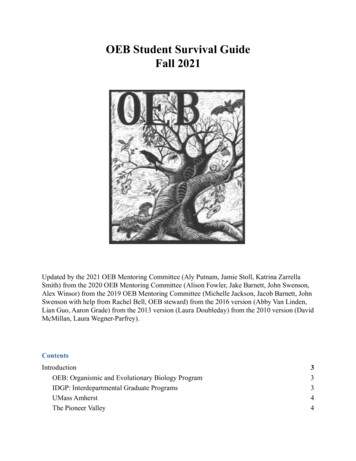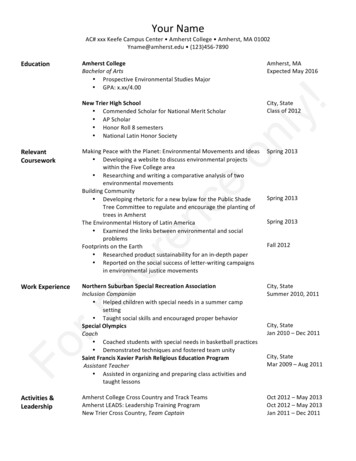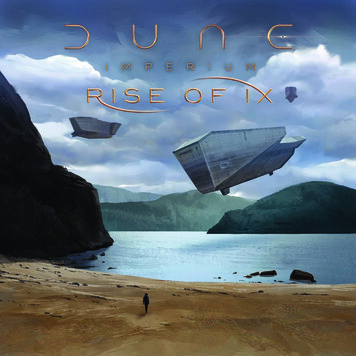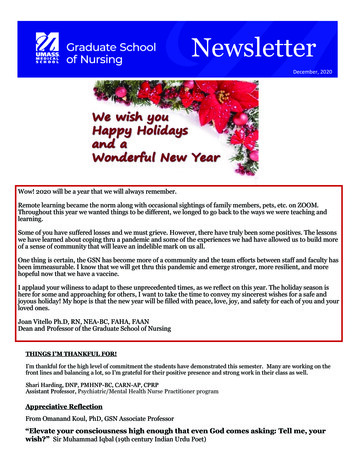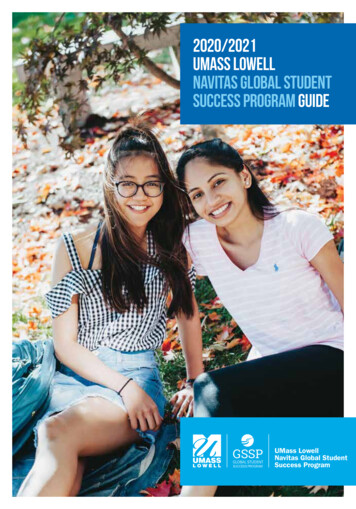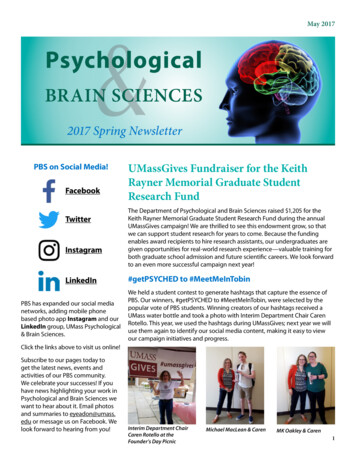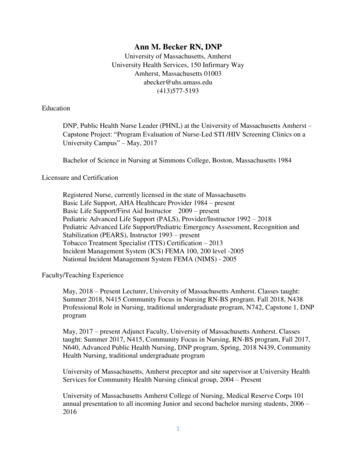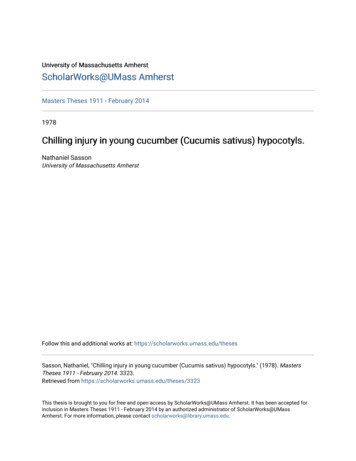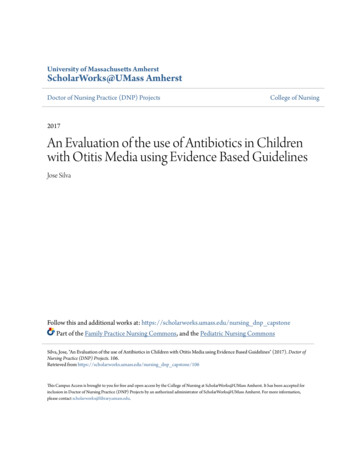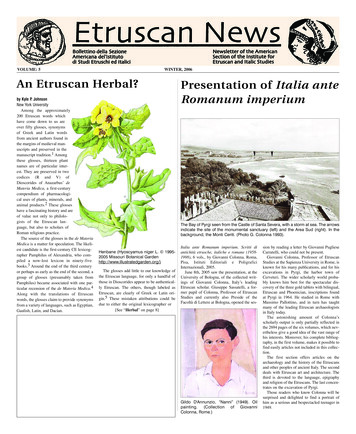
Transcription
VOLUME: 5WINTER, 2006An Etruscan Herbal?by Kyle P. JohnsonNew York UniversityAmong the approximately200 Etruscan words whichhave come down to us areover fifty glosses, synonymsof Greek and Latin wordsfrom ancient authors found inthe margins of medieval manuscripts and preserved in themanuscript tradition.1 Amongthese glosses, thirteen plantnames are of particular interest. They are preserved in twocodices (R and V) ofDioscorides of Anazarbus’ deMateria Medica, a first-centurycompendium of pharmacological uses of plants, minerals, andanimal products.2 These glosseshave a fascinating history and areof value not only to philologists of the Etruscan language, but also to scholars ofRoman religious practice.The source of the glosses in the de MateriaMedica is a matter for speculation. The likeliest candidate is the first-century CE lexicographer Pamphilus of Alexandria, who compiled a now-lost lexicon in ninety-fivebooks.3 Around the end of the third centuryor perhaps as early as the end of the second, agroup of glosses (presumably taken fromPamphilus) became associated with one particular recension of the de Materia Medica.4Along with the translations of Etruscanwords, the glosses claim to provide synonymsfrom a variety of languages, such as Egyptian,Gaulish, Latin, and Dacian.Presentation of Italia anteRomanum imperiumThe Bay of Pyrgi seen from the Castle of Santa Severa, with a storm at sea. The arrowsindicate the site of the monumental sanctuary (left) and the Area Sud (right). In thebackground, the Monti Ceriti. (Photo G. Colonna 1993).Henbane (Hyoscyamus niger L. 19952005 Missouri Botanical Gardenhttp://www.illustratedgarden.org/)The glosses add little to our knowledge ofthe Etruscan language, for only a handful ofthose in Dioscorides appear to be authentically Etruscan. The others, though labeled asEtruscan, are clearly of Greek or Latin origin.5 These mistaken attributions could bedue to either the original lexicographer or[See “Herbal” on page 8]Italia ante Romanum imperium. Scritti diantichità etrusche, italiche e romane (19581998), 6 vols., by Giovanni Colonna. Roma,Pisa, Istituti Editoriali e PoligraficiInternazionali, 2005.June 8th, 2005 saw the presentation, at theUniversity of Bologna, of the collected writings of Giovanni Colonna, Italy’s leadingEtruscan scholar. Giuseppe Sassatelli, a former pupil of Colonna, Professor of EtruscanStudies and currently also Preside of theFacoltà di Lettere at Bologna, opened the ses-Gildo D'Annunzio, “Nanni” (1949). Oilpainting. (Collection of GiovanniColonna, Rome.)sion by reading a letter by Giovanni PuglieseCarratelli, who could not be present.Giovanni Colonna, Professor of EtruscanStudies at the Sapienza University in Rome, isknown for his many publications, and for hisexcavations in Pyrgi, the harbor town ofCerveteri. The wider scholarly world probably knows him best for the spectacular discovery of the three gold tablets with bilingual,Etruscan and Phoenician, inscriptions foundat Pyrgi in 1964. He studied in Rome withMassimo Pallottino, and in turn has taughtmany of the leading Etruscan archaeologistsin Italy today.The astonishing amount of Colonna’sscholarly output is only partially reflected inthe 2694 pages of the six volumes, which nevertheless give a good idea of the vast range ofhis interests. Moreover, his complete bibliography, in the first volume, makes it possible tofind easily articles not included in this collection.The first section offers articles on thearchaeology and the history of the Etruscansand other peoples of ancient Italy. The seconddeals with Etruscan art and architecture. Thethird is devoted to the language, epigraphyand religion of the Etruscans. The last concentrates on the excavation of Pyrgi.Those readers who know Colonna will besurprised and delighted to find a portrait ofhim as a serious and bespectacled teenager in1949.
Letter to the EditorsWe’re glad we’re on this trip.CHORUS:Etruria’s the place for meThere is so much here to seeI am sure you all agreeWe’re glad we’re on this trip.Charlene KrinitzNew YorkEtruscan tour group, Archeological Tours, June 2005To the Editors:Here is the group song for ourArchaeological Tours trip through Etruscanplaces:THE BATTLE HYMN OF ETRURIAEtruscan art is very old I’m sure you’ll all agreeThe Vatican Museum is where we saw all we could seeCENSOREDWe’re glad we’re on this trip.Funerary ashes were placed in a house shaped urnEverybody knows that some day they will get their turnFirst you die, they light a match and then they watch youburnWe’re glad we’re on this trip.Talking on the mike Larissa first would do a testSpeaking at the right length wasn’t easy she confessedAfter a few tries she found 6 inches was her bestWe’re glad we’re on this trip.Talking of Apollo there was quite a lot to sayAs we were discussing him Larissa led the wayWhen we asked where he came from Larissa said, “OyVeii!”We’re glad we’re on this trip.On to Ceveteri where we went from tomb to tombWhen we went down into them around us all was gloomEven when you died you still could not have your ownroomWe’re glad we’re on this trip.CHORUS:Etruria’s the place for meThere is so much here to seeI am sure you all agreeWe’re glad we’re on this trip.Saw some ancient sites where many ruts just seemed tostartDid they play a major role or only a small part?Could be that’s the reason all their food’s served “a lacarte!”We’re glad we’re on this trip.When it comes to olden times Larissa is prosaicEspecially when she talks about the times that are archaicLaura also comes along she’s our apotropaicWe’re glad we’re on this trip.The artifacts in Murlo seemed to have the same refrainIt was set up on a hill midst beautiful terrainThe most exotic object found was that of our John WayneWe’re glad we’re on this tripIn Volterra there’s a place to see the statue SposiHe and his purported wife, they didn’t look too cozyWhat’s the difference, when you’re dead the future’s notPage 2too rosyWe’re glad we’re on this trip.CHORUS:Etruria’s the place for meThere is so much here to seeI am sure you all agreeWe’re glad we’re on this trip.Laura’s not imposing yet she’s always near the sceneLets you sit in front if she sees that you’re turning greenShe is good at counting if it’s only to 19We’re glad we’re on this trip.Went to Marzabotto, it’s a place that’s very graveThey put stones down on the streets in order not to paveThen we had a picnic lunch we all thought was a raveWe’re glad we’re on this trip.Walking down the streets of Florence, we saw on thewallsFamily crests of Medici they put in all their hallsOur guide said you see much better if you’ve fewer ballsWe’re glad we’re on this trip.Through the archeological museum Elena made us marchWe got very thirsty and our throats were dry as starchBut we learned that Dr. Scholl invented the first archWe’re glad we’re on this trip.CHORUS:Etruria’s the place for meThere is so much here to seeI am sure you all agreeWe’re glad we’re on this trip.Stayed in Torgiano in a place fit for a nunIt was a great place to rest from being on the runEven in the shower people had a lot of funWe’re glad we’re on this tripThe Cannicella Venus is a statue that is bareShe is very sacred cause she has her pubic hairConsidering her age she doesn’t look the worse for wearWe’re glad we’re on this trip.Outside Orvieto was the city of the deadWe didn’t want to go there cause we wanted to be fedIt was so hot walking that we all became beet redWe’re glad we’re on this trip.Luca is our driver and the job he does is greatAlways picks us up on time, he isn’t ever lateExcept the time he had a flat and left us at the gateWe’re glad we’re on this trip.Tomorrow some of us will get our last chance to seeRomaIt’s an opportunity to see St. Peter’s domaThen we board our planes and most of us will head forhomaTo the Editors:About the centrality of Etruscan studies: donot forget the “Dodecapolis.” This is the firstexample of a confederation in Italy andEurope, and this programme started 2500years ago in Tuscany and Lazio and wasenlarged to Northern and to Southern Italywith the chief towns Mantua and Capua! Thismeans that they already had an exact concernof Confederation, which in Latin is “unitedpacts.” (The most important pacts and ruleswere religious.)Best personal regards,Guido BelfiorePrato, ItalyTo the Editors:I thought you would find this menu interesting. Chef Walter Potenza has an Etruscanrestaurant here [in Providence], has his ownTV show and is very creative.Below is the menu [of a Roman dinner heprepared]:To the Editors:As for your devilishly clever crossword, Ibelieve that the fatal flaw may consist in 5down – the clue obviously demands as ananswer the famous PhERSNA, “Brad Pitt”(whom I would bet an Etruscan AS, if I hadone, that a certain female author and mostfemale readers of this fourth issue had a mental picture of), but ACHLE seems to fitinstead, except that a good Etruscan scribesuch as yourself should have used the singleEtruscan letter (Greek Chi) for “CH”.I hope my joke about Brad Pitt wasn’t toodense – he was the star who played Achilles inthe recent movie “Troy,” and slew Eric Bana,Hector, Achilles being the answer to the cluein your crossword, in Etruscan, spelled asAChLE Foods of Ancient RomeHors d’oeuvresAssorted pork salami prepared in the style ofthe Romans, served with breads of thetimesNasti Panes (sweet bread)Panis Plebeius (bread of the poor)Confusaneus (bread of the rich)Pecorino Romano stagionato con melocotogno: Roman sheep milk cheese, aged incaves, served with quince paste)Banchetto RomanoMinutal Marinum: rich seafood soup madewith perch and oystersPatina de piris imperiale: savory pear andasparagus tart with hard cooked eggs andricotta. Served with grape sauce.Pullum Numidicum: guinea hen with sweetJeff HillEditors’ note: Although Jeff Hill found thefatal flaw, he did not propose a solution to fixit. The contest remains open!!ETRUSCAN NEWSEditorial Board, Issue #5, December 2005President of the U.S.Section of the Istituto diStudi Etruschi ed Italici,ex officioLarissa BonfanteClassics DepartmentNew York University25 Waverly PlaceNew York, NY 10003lb11@nyu.eduEditor-in-ChiefJane WhiteheadModern and Classical LanguagesValdosta State UniversityValdosta, GA 31698Language Page EditorRex Wallacerwallace@classics.umass.eduClassics DepartmentUniversity of MassachusettsAmherst, MA 01003Editor for the FellowsElizabeth de G. Colantoni elizabeth.colantoni@oberlin.eduClassics DepartmentOberlin CollegeOberlin. OH 44074Guest Editor,Book ReviewsFrancesco de AngelisArt History and ArchaeologyColumbia UniversityNew York, NY issions, news, pictures, or other material appropriate to this newsletter may be sent toany of the editors listed above. The email address is preferred. For submission guidelines,see Etruscan News 3 (2003) 9. Nominations for membership in the Section may be sent toLarissa Bonfante at the above address.
and sour sauceFiletti di maiale e noci con condimento diprugne in ristretto di melograno: tenderpork filet seared with rosemary and walnutsin a sauce of prunes and pomegranate.DessertCassata alla Romana: Roman style cake filledwith ricotta, candied fruit and marzipanEuchytes: sweet fritters served with honeySelection of wines from Central and SouthernItalyPamelee MacFarlandProvidence, RITo the Editors:When does my subscription end? I’m goingto be travelling and I don’t want to let myfavourite periodical lapse by mistake.Maria King ConstantinidisSouth Yarmouth, MATo the Editors:In the Archaeological Museum in Sofia Iattended the presentation of Kitov’s newestwebsite: http://www.thracetemp.orgNikola TheodossievSofia, BulgariaA r t i c l e sA Possible SouthEtruscan Tomb Groupby Angela Murock HusseinGreek-style pottery workshops have longbeen recognized in Etruria, where there was ahuge demand for such products.1 This phenomenon has its origin with the GreekGeometric Period when intensive trade relations between Greece and the Tyrrhenianbegan. The corpus of Italian Geometric piecesis increasing as many more pieces fromEtruria are being identified and published.2Greek style pottery that was made in Etruriacan be differentiated from pottery importedfrom Greece by such characteristics as itsItalian fabric or Etruscan shapes. Meanwhile,the decoration on Etruscan vases of Greekstyle is often as fine as those produced by thefinest painters in Greece, and is evidence ofthe presence of Greek immigrant craftsmen inLetter to our ReadersWinter 2006Dear Readers,We realize with horror that it has been a year since our last issue. It has been quite a yearin the lives of your editors: marriage, deaths, relocation, tenure, a new excavation Therehave been three deaths in the families of your two editors, and for our associate editor of“Students in Action,” completion of the PhD, marriage, and a position at Oberlin.In this issue we are happy to introduce a guest editor of Book Reviews. Francesco deAngelis is a product of the Scuola Normale in Pisa, has held a two-year fellowship at theGetty, and is now on the Art History faculty of Columbia University. A professor of RomanHistory, he has published important works on Etruscan subjects, and is creating a web siteon the urns of Chiusi: http://charun.sns.it.A first for us: an article from Etruscan News 3 was cited in Studi Etruschi. An unpublishedinscription, sent to us in a note by Dominique Briquel, was commented on in the section onEtruscan epigraphy (REE) of Studi Etruschi (2004). We want to mention two other journalsthat have been reporting important news on Etruscan subjects: Jean MacIntosh Turfa is nowin charge of Etruscan reviews in the Bryn Mawr Classical Review (BMCR):ccat.sas.upenn.edu/bmcr/ ARCHEO has continued to publish extraordinary photographs andarticles on Etruscan material, including such recent finds as the Sarteano Tomb (See articleby Alessandra Minetti in Etruscan News 4). One of our most enthusiastic readers, Jeff Hill,writes us from Australia that he is willing to prepare an index for the past issues of EtruscanNews. Jeff Hill is also the winner of our crossword puzzle competition in the last issue.Several important exhibits and reopenings are scheduled for the near future: the imminentreopening of the Getty Villa and its galleries of ancient art; the inauguration in 2007 of theMetropolitan Museum’s renovated Roman and Etruscan galleries, with the newly-restoredMonteleone chariot as its centerpiece; the Bunte Götter, or Colored Gods, exhibit whichstarted in Munich and has been traveling. We ask our readers to let us know about otherupcoming events and exhibits, and welcome their brief reports and reviews.Finally, we sadly report the deaths of colleagues. Timothy Gantz, whose obituary appearsin this issue, worked at Murlo as a graduate student; his splendid Early Greek Myth hasbecome the standard text, and is enormously useful for our understanding of Etruscaniconography. A colleague from Belgium reported the loss of Roger Lambrechts, whose manyimportant contributions to Etruscan studies included the original conception of a CorpusSpeculorum Etruscorum, or Corpus of Etruscan Mirrors (CSE); he also later created a website for Etruscan and Praenestine mirrors: pot-pourri.fltr.ucl.ac.be/mirroirs/ Helmut Rixleaves his invaluable reference work, Etruskische Texte, as a legacy to us. It is especiallypainful to mention the death of Giuliano Bonfante in Rome: he was glad to write the linguistic section of The Etruscan Language: An Introduction, because, as he said, it was interesting for an Indoeuropean scholar to be working on a non-Indoeuropoean language.Please join us at the Annual Meeting of the AIA in Montreal. Our late evening receptionwill be January 7, 10:00-12:00 P.M., where we look forward to seeing many of you.Although Etruscan News can now be viewed on its own web site, we ourselves are very fondof the tabloid format, and will continue to send out the paper copy to those who subscribe.Your subscription, and any donations, will also support activities such as the annual reception and graduate student symposia, and what we hope to be an expanded series of events:lectures, tours Any suggestions?Sincerely yours,The Editorsfig. 1Etruscan centers.3 In order to gain a morecomplete picture of the Greek pottery workshops in Etruria, it is important not only toidentify excavated pieces but to connect thosepieces that lack context.Three unprovenanced Greek Geometricstyle vases may not only be representatives ofthe same workshop, but also products fromthe same Etruscan tomb group. Two are todayin American museums. These vessels possiblyoriginate in a larger collection from Rome,much of which is in the National EtruscanMuseum at the Villa Giulia. Certainly fromthis Roman collection is a third piece that isclosely connected to the above-mentionedvases. The commonalities between these threevessels, as well as their similar histories, mayindicate a single find spot.The first piece is in the Cleveland Museumof Art, Acc # 1993.1 (fig. 1) and was purchased at auction in 1992.4 This bird-shapedaskos has been well known since the NorbertSchimmel collection, of which it was a part,was published in the 1970s.5 It represents anextremely fine example of Greek-styleGeometric painting. The second piece is a barrel-shaped oinochoe from the collection of theMetropolitan Museum of Art, Acc # 1975.363(fig. 2). The Metropolitan barrel vase was agift from the Norbert Schimmel Foundation tothe Metropolitan Museum in 1975.6 The vaseis a similarly well executed Geometric stylepiece that matches the Cleveland askos inquality and artistic style. The two vases wereacquired at the same time, although there is noindication given as to their source.7The barrel vase and bird askos shapes haveexact parallels in Etruria, not in Greece orMagna Graecia. Tomb X from the Olmo BelloBisenzio, today in the Villa Giulia, has twobird askoi and a barrel vase.8 A recently published tomb, Tomba 6 Settembre from Vulci,has also produced a bird askos.9 Therefore,both the Cleveland and the New York piecesare very high quality examples of Greek-stylepieces made in Etruria.It is notable that the Cleveland askos andthe New York barrel vase, as well as theirabove-mentioned parallels, are painted in a[continued on next page]fig. 2fig. 3Page 3
fig. 7fig. 5fig. 4fig. 6style related to Euboean Late Geometric figural painting. The decorative repertoire ofthese pieces is a stylistic strain of Euboeanderivation. They all show an artistic affinityfor certain motifs, such as pendent triangles,hatched maeanders or swastikas, checkerboards, thick vertical wavy lines and crosshatched triangles. Thus, these pieces andother similar vases have been identified witha large South Etrurian workshop for Greekstyle ceramics, the Workshop of the VulciBiconical.10The Cleveland and New York vases lackprovenance. The only parallels are those mentioned from Vulci and Bisenzio in the hinterland around Vulci. The two pieces fromAmerican museums demonstrate a higherdegree of artistic skill than the parallels and sowere probably made in a wealthy cosmopolitan center. The workshop of the Vulci biconical was located at the powerful Etruscan center of Vulci, so this was likely the source forboth vases. With the parallel grouping inBisenzio, it is a more compelling argumentthat these originate in the same wealthy tombfrom Vulci.The third piece, an oinochoe from theCima-Pesciotti collection, which is today inthe Villa Giulia Museum, Inv. 74092 (fig. 3),is closely linked to the New York andCleveland vases.11 This Villa Giulia vase hasalready been recognized as belonging to thesame workshop as the Cleveland and NewYork pieces.12 Although this piece is Greek inshape, it was painted almost certainly by thesame hand as the Cleveland askos and theNew York barrel vase. All of the motifsappearing on this vase match the repertoire ofthe other two pieces. The large figural panelson the neck and handle of the oinochoe are themost telling. The heads of the water birds onthe oinochoe are rendered in exactly the sameway as on the Cleveland askos (figs. 4-5).This oinochoe also bears animal figures thatwere experimentally derived from the charac-Page 4teristically Euboean scene of the rampantgoats which appears on the New York barrelvase (figs. 6-7).Many pieces from Cima-Pesciotti, a privatecollection held in Rome and made up primarily of finds from southern Etruria, were purchased by the Italian government for the VillaGiulia in 1972.13 Many of the pieces from theCollection, however, were sold on the antiquities market in 1964.14 The New York barrelvase and the Cleveland askos may have beenpurchased from part of the Cima-Pesciottigroup, since we only know that they were inthe Schimmel collection before the early seventies. If this is the case, it is likely that thePesciotti oinochoe is part of the same tombassemblage as the two pieces in America.A similar oinochoe with the checkerboardon the shoulder and a handle strut was foundwith a bird askos in Tomba 6 Settembre fromVulci.15 The Geometric style bird askos canbe associated with barrel oinochoai andcheckerboard oinochoai in two, albeit separate, tombs. The pieces are possibly related insome type of table service, however. Tomb Xat Olmo Bello included a barrel vase and twobird askoi. Instead of an oinochoe, Tomb Xcontained a wide-mouthed jug, also decoratedin Greek style.16 The jug would have fulfilledthe same function as an oinochoe. All of thepieces from Tomb 6 Settembre were found ina fragmentary state.17 It cannot be ruled outthat a barrel vase was included in the contentsof the tomb.The Cleveland askos is related to the NewYork barrel vase by acquisition history. ThePesciotti oinochoe is related to those two bystyle and artist. All most likely originated inVulci and were possibly all part of thePesciotti collection before that collection wassold in the sixties and seventies. These threevessels were all painted by the same artist andtherefore also may come from the samewealthy Vulcente tomb group.1. For the most recent summary of this phenomenon, F. Canciani, “La Ceramica ItaloGeometrica,” 9-15; M. Martelli, “LaCeramica Etrusco-corinzia,” 23-30; M. A.Rizzo, “La Ceramica a Figure Nere,” 31-42;“La Ceramica a Figure Rosse;” all in M.Martelli (ed.), La Ceramica degli Etruschi(Rome 1987).2. Åkerstrom’s work on the subject remainsan important starting point. A. Åkerstrom,Der geometrische Stil in Italien (Leipzig1943). New pieces, however, have been addedto the corpus of known pieces. M. FalconiAmorelli, “Corredi di tre tombe rinvenute aVulci nella necropoli di Mandrione diCavalupo,” StEtr (1969) 181-211. “Materialiarcheologici da Vulci,” StEtr (1971) 193-211.F. Canciani, “Un biconico dipinto da Vulci,”DialArch (1974-5) 79-84. F. Canciani, “Trenuovi vasi “italo-geometrici” del Museo diVilla Giulia,” Prospettiva (1976) 26-29. M.Fugazzola Delpino, “Vasi Biconici TardoGeometrici,” ArchCl (1976) 3-9. “Crateri inargilla figulina del Gemetrico Recente aVulci,” MEFRA (1978) 465-514. F. Delpino,“Ceramiche tardo geometrico in Etruria: trebiconici,” PP (1981)102-5. A. SgubiniMoretti, “Ricerche Archeologiche a Vulci:1985-1990,” in M. Martelli (ed.), TyrrhenoiPhilotechnoi (Rome 1994). A. MorettiSgubini, Veio, Cerveteri, Vulci: città d’Etruriaa confronto (Rome 2001).3. Along with new identifications, there havealso been attempts to classify the ItalianGeometric pieces. H. Isler, “Ceramisti Greciin Etruria,” NumAntCl (1983) 9-48. A.Murock Leatherman, “Italian GeometricPottery: Workshops and Interactions,”Unpublished Dissertation, Brown University,2004.4. Antiquities from the Norbert SchimmelCollection, Sotheby’s, Wednesday December16, 1992, New York, No. ork.asp?deptgroup 14&recNo 42&display 5. O. W. Muscarella (ed.), Ancient Art: TheNorbert Schimmel Collection (Mainz 1975)No. 65bis. J. Stettgast, Von Troja bis Amarna.The Norbert Schimmel Collection, New York(Mainz 1978) No. 67.6. Annual Report of the Trustees of theMetropolitan Museum of Art 1975-76, 45.“Ancient Art: Gifts from the NorbertSchimmel Collection,” The MetropolitanMuseum of Art Bulletin (Vol. 49, No. 4) No.52, 60. http://www.metmuseum.org/toah/ho/04/eust/ho 1975.363.htm7. See Note 5 above, Ancient Art.8. Åkerstrom, above note 1, 55-59, Taf. 12-13.9. Moretti Sgubini, above note 2, 188-199.Another barrel oinochoe from Italy, also connected to Euboean painting, was discovered inPithekoussai; G. Buchner, “Recent Works atPithekoussai (Ischia), 1965-71,” ARepLond(1970-71) 64-65. This one, however, lacks thehigh conical foot of the Etruscan pieces whichwas apparently an Etruscan tendency. SeeMurock Leatherman above note 2, 143.10. Murock Leatherman, above note 2, 24-89.Isler above note 2, 27-28.11. M. Moretti (ed.), Nuove Scoperte eAcquisizioni nell’Etruria Meridionale (Rome1975) 197, Tav. 47. F. Canciani, “Tre nuovivasi “italo-geometrici” del Museo di VillaGiulia,” Prospettiva 4 (1976) 27-28.12. Isler, note 10 above.13. M. Moretti (ed.), Nuove Scoperte eAcquisizioni nell’Etruria Meridionale (Rome1975) 179.14. A. M. Moretti Sgubini (ed.), The VillaGiulia National Etruscan Museum ShortGuide (Rome 2001) 50.15. A. M. Moretti Sgubini, Veio, Cerveteri,Vulci: città d’Etruria a confronto (Rome2001) 188-199, III.b.1.4, III.b.1.3.16. Akerstrom, op.cit., 58 Taf. 12.2.17. Op. cit.
L a n g u a g eA neglected Etruscaninscriptionby Dominique BriquelThis inscription is by no means a recentdiscovery — it was published in 19061 —but it had been neglected by Etruscologists.It was never included in corpora of Etruscaninscriptions, even the 1991 EtruskischeTexte, by H. Rix and his collaborators,which is the most complete work avalaibletoday about Etruscan epigraphy; nor was itquoted in books or articles about Etruscans.It offers a very short text:2 only two words,pumpun larthal, with letters written left toright, in a classical onomastic formula,“Pumpun son of Larth.” Its interest, however, does not lie in its meaning, which bringsnothing new to our knowledge of theEtruscan language, but in the place where itwas found: it was discovered in a tomb ofthe necropolis of Gouraya, ancient Gunugu,150 km. west from Algiers on theMediterranean coast, in modern Algeria.Thus it was taken into account almost exclusively by specialists of African antiquities –Stéphane Gsell in 1906, Pierre Wuillemierin 1928, Marcel Le Glay in 1956, JehanDesanges in 19803 – and was not noticed byspecialists of ancient Etruria. Nevertheless,it throws an interesting light on the persisting relations between Etruria and Africa inthe late period to which this documentbelongs (2nd to 1st c. B.C.).The text is written on a small bronze disc(diam. 7 cm), which bears on its other facethe heads of two rams facing each other. Theletters of the inscription appear raised: thispoint, together with the strange direction ofwriting which is contrary to the normalEtruscan use, shows that the name of thisPumpun son of Larth was inscribed on themold with which the object was made. Thesedetails lead one to see this disc as a kind oftessera hospitalis, i.e. an object permitting totwo persons linked by relations of hospitalityto recognize each other. The existence of suchobjects in antiquity is widely attested;Plautus’ Poenulus (v. 955-8, 1049-55) gives agood example of their use by Punic and Greektraders travelling abroad. The discovery of atessera hospitalis inscribed with an Etruscanname in Gouraya attests the persistence oflinks between Etruria and Punic or PunicizedAfrica long after the great period of EtruscoCarthaginian relations, in the time of the battle of Alalia (535 B.C.). At this time both peoples, who were then the dominant powers onthe Tyrrhenian sea, had concluded alliancetreaties, mentioned by Aristotle (Politics, 3, 5,11). In the tombs of Gouraya was found abundant pottery of the so-called Campana B wareof the 2nd to 1st c. B.C., which seems to havebeen produced in Etruria. Even in aMediterranean world now controlled byRome, Etruscans could still maintain traderelations with partners in Africa; the inscribeddisc of Gouraya bears witness to it.1. I could study this document, which is keptin the Musée National des Antiquités ofAlgiers, thanks to the courtesy of N. Drias,director of the museum, to whom I am verygrateful. A complete study will appear in theAnnales du Musée National des Antiquités.P a g e2. The text given by previous editors was mistaken, and has to be corrected.3. S. Gsell, Bulletin archéologique duComité des Travaux Historiques etScientifiques (1906) CCLXXIII-CCLXXIV;P. Wuilleumier, Description de l’Afrique duNord entreprise par ordre de M. le Ministre del’Instruction publique et des Beaux-Arts,Musées et collections archéologiques del’Algérie et de la Tunisie, 22, Musée d’Alger,Supplément (Paris 1928) 20-21; M. Le Glay,“Les religions orientales dans l’Afrique ancienne d’après les collections du MuséeStéphane Gsell,” Les conférences-visites duMusée Stéphane Gsell (Algiers 1956) 8-9; J.Desanges, Pline l’Ancien, Histoire naturelle,livre V, 1-46 (Paris 1980) 161, n. 20. See alsoA. Schulten, “Archäologische Funde im Jahre1906,” Archäologischer Anzeiger (1907 2) c.174-175, Y. Liébert, “Une inscription latined’Algérie,” Revue des Études Latines 74(1996 [1997]) 38-46, M. Dorbane and J.-P.Laporte, catalogue of the exhibition L’Algérieen héritage, art et histoire (Paris 2004) editedby N. Ferhat, E. Delpont, Y. Koikas (Arles2003) 185, n 99.Inscription from Gouraya: Pumpun larthalEtruscan Inscriptions in theRoyal Ontario Museum1accurate transcription of this inscription is in (3).1. At the Royal Ontario Museum in Toronto, Iviewed (8/14/01) two Etruscan inscriptions oncinerary urns of a cylindrical type (olla) commonto Chiusi. The urns were published in Hayes 1985under the catalogue entry numbers G13 and G15.2Another inscription on a cinerary urn of this sametype, G14,3 was published by Hayes in StudiEtruschi (Hayes 1975) and so
Family crests of Medici they put in all their halls Our guide said you see much better if you've fewer balls We're glad we're on this trip. Through the archeological museum Elena made us march We got very thirsty and our throats were dry as starch But we learned that Dr. Scholl invented the first arch We're glad we're on this trip .
